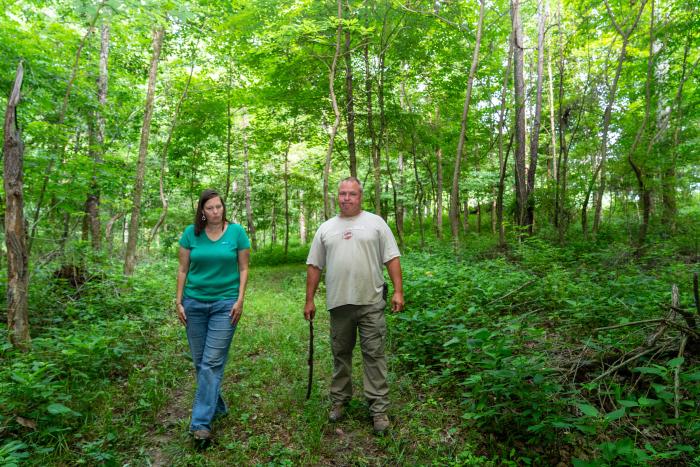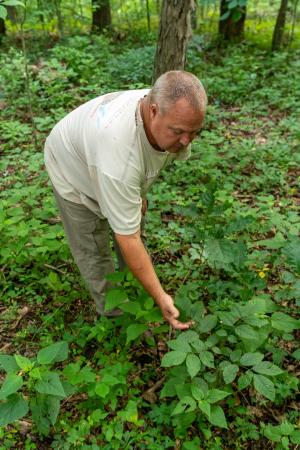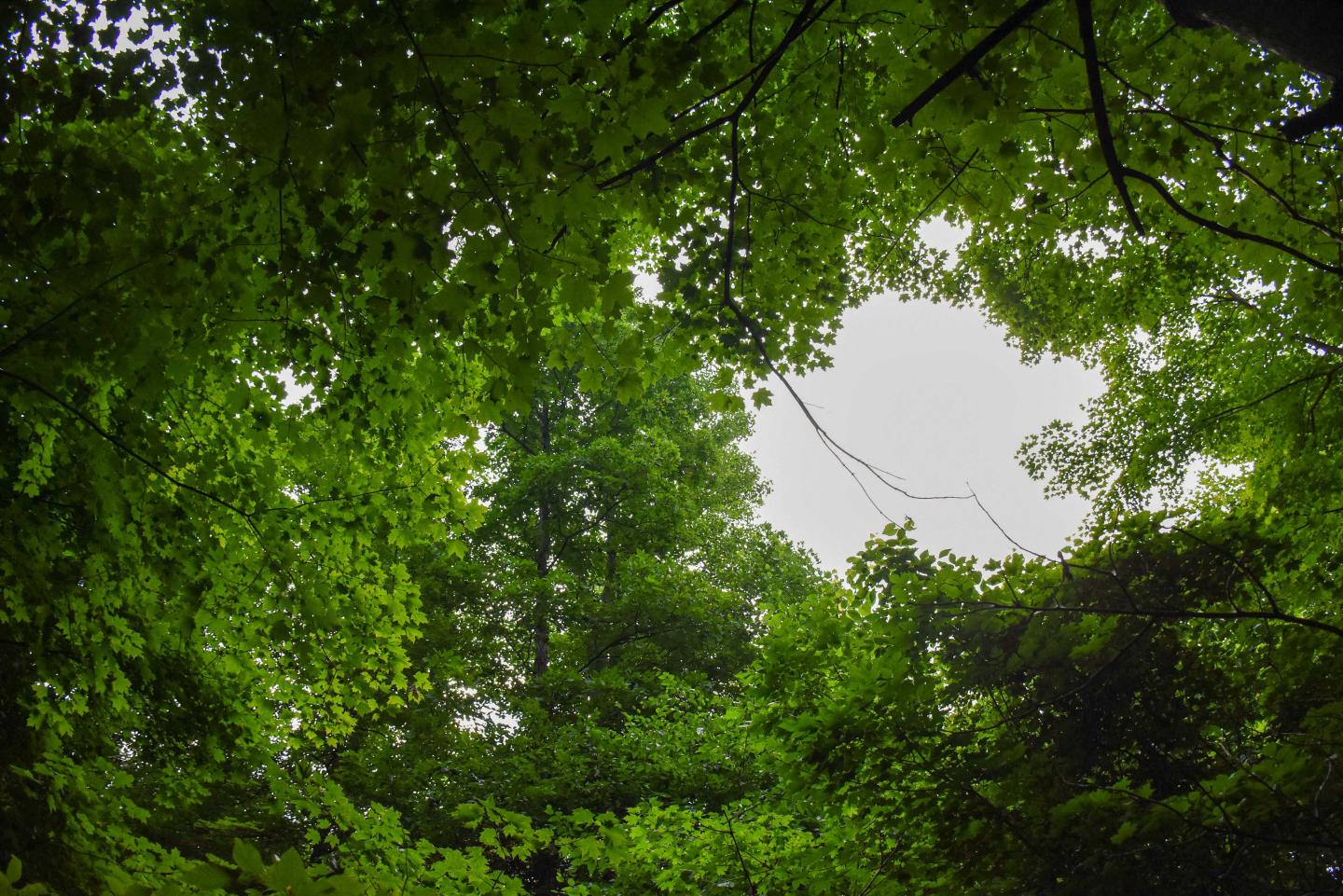Franklin County, Indiana Landowner Restores Forest to it Native State

Louie Lane III worked with NRCS to remove invasive species and restore his 50 acres of forestland
By Carly Whitmore, Indiana NRCS Public Affairs Intern
As the sun shines through the canopy down to the forest floor, it highlights the wild berries and saplings, inviting wildlife to explore. Birds chirp and insects crawl, bringing to life the new trees, undeterred by the invasive autumn olive that used to occupy the space. This slice of forest in northwestern Franklin County, Indiana is returning to its original glory.
Louie Lane III and his wife Kristen are the ones responsible for this beautiful forest. They have been surrounded by their own personal oasis for nearly six years after stumbling across the plot of land while looking for a place to fully experience the outdoors and call their new home.

“It was the forest we wanted,” Lane said. “We wanted the forest ground, and we’re outdoor people and we wanted to put our part into it.”
The Lanes’ 50-acre forest has a long history. Many years before they purchased the land, it was used as cropland and pasture, as indicated by the leftover freshwater springs buried deep in the forest. The freshwater springs also provided clean water to an abundance of tall oak trees that were eventually logged as far back as 50 years ago and stumps from the harvest still dot the landscape throughout the woods.
But as soon as they moved in and began to explore the forest, Lane discovered the autumn olive. While autumn olive is a shrub that was once used in Indiana to fix nitrogen in the soil and to feed wildlife, no one would know how invasive it could be for many years after it was planted. It quickly became one of the top invasive plants in Indiana.
Autumn olive is harmful in several ways, but, mainly, it outcompetes the native species already growing in the forest. Once it is established in a forest, it can quickly spread and replace the native species in the understory. The lack of predators or pests that feed on autumn olive results in a potentially severe infestation without intervention.
In the spaces left bare by logging on the Lanes’ property, autumn olive moved in and made the forest its home.
“You couldn’t even see into the woods,” Lane said. “(Autumn olive) was all the way up to the road and 10-feet high.”
Determined to restore the forest to its original glory and remove the harmful autumn olive, Lane developed a plan soon after buying the land. He worked with his Indiana Department of Natural Resources (IDNR) District Forester, who walked the forest and advised Lane on potential autumn olive management strategies. This served as the beginning of Lane’s brush management planning.
He then approached his local USDA service center in 2015 to see how the Natural Resources Conservation Service (NRCS) could assist him in the removal of the harmful invasive species.

In 2015, Lane applied for NRCS’ Environmental Quality Incentives Program (EQIP) to do brush management, specifically for autumn olive. EQIP helps fund invasive species and makes helping the land a little easier on landowners like Lane.
Even with the help from NRCS, Lane needed to get creative with his management strategy to rid the forest of autumn olive. He began his autumn olive management in early 2017 and it took three years and few different ideas to clear the brush.
“The first year, we cut with chainsaws, and got the biggest, tallest stuff that we could get,” Lane said. “The second year, we had very little chainsaw use, just maybe a couple that were missed here and there. We mostly use loppers and machetes ... Then the third year, we just used loppers. And we went around and got all the small stuff that we could.”
The final step was to spray parts of the area with, a herbicide that is specifically used for brush such as autumn olive, and was necessary to prevent regrowth.
“I knew from my experience that it would grow back, no matter what we did…so (herbicide) is what we picked,” Lane said.
Over the course of his three-year brush management agreement, Lane estimates he and his team of helpers walked the entire 50-acre forest floor, removing autumn olives nearly every step.
The forest was so dense before they cleared the brush that Lane said light could barely touch the forest floor. Lane recalled the IDNR district forester telling him the forest would look bare and empty after the autumn olive was removed, which initially worried Lane. But he said he decided to go forward after being assured, “it will fill back up with what you want in here, which is new trees that will all be competing with each other for growth and things will get healthy and you'll get your cover back.”
It’s only been a year since the last of the forest was treated and the forest has begun to return to its natural state. The undergrowth is full of plant and animal life and sunlight now peeks through the canopy reaching the forest floor.
During just a short walk through the woods, Lane was able to find multiple oak saplings that have started to grow transforming the forest back into its native landscape. Before the removal of the invasive autumn olive, they never would have had a chance to survive.

“I don't know if those acorns were just sitting there waiting to take off under the ground or what, they just popped right out,” Lane said.
Four years after Lane began clearing the autumn olive, the forest is looking full and beautiful, and is inviting more wildlife than ever before.
Lane makes sure, though, to continue to accommodate the growing wildlife population. As he continues to manage the forest, Lane will use brush trimmings to create piles for rabbits to use for shelter.
In addition to rabbits, Lane has seen deer, bobcats, birds of prey and songbirds, reptiles and an abundance of insects since removing the autumn olive.
Lane loves to share the property he treasures so much with others. Doing his part and restoring the forest makes Lane so excited and proud.
“I'm like a little kid. I get excited about all that stuff. Definitely thrilled to death about it,” Lane said.
And with oak saplings sprouting and wildlife coming out of the woodwork, the Lanes’ northwestern Franklin County forest has returned.
Additional Information
Environmental Quality Incentives Program - Indiana
The Environmental Quality Incentives Program (EQIP) provides financial and technical assistance to agricultural producers and non-industrial forest managers to conserve natural resources while strengthening their operations.
Learn MoreINDIANA FORESTRY RESOURCES
Forests and woodlots are constantly changing. To get the most out of your property to meet your wildlife, recreational, aesthetic or economic goals, some type of regular management will be necessary. Fortunately, there are many resources available to help you.
INDIANA NRCS HOMEPAGE
For more information about NRCS programs offered in Indiana and how experts throughout the state can help you address natural resource concerns on your land, visit the Indiana NRCS homepage.

